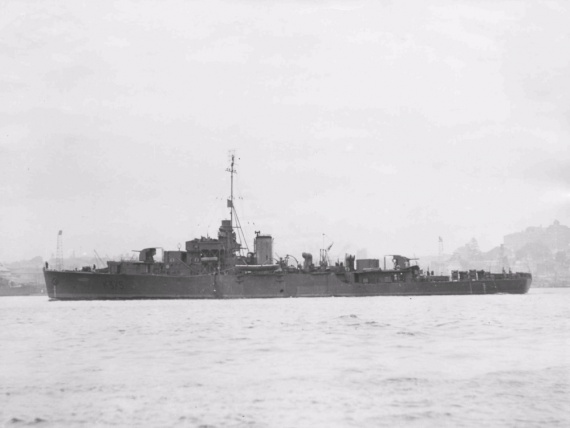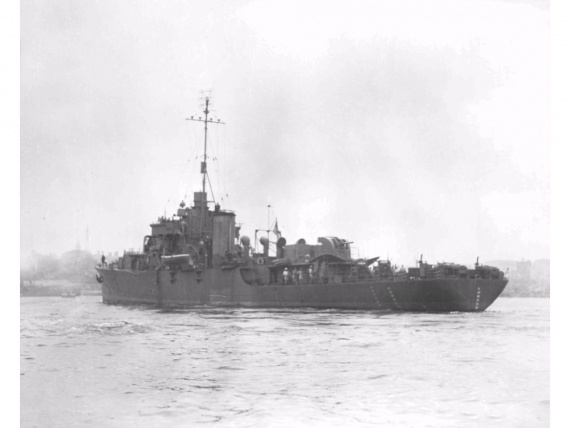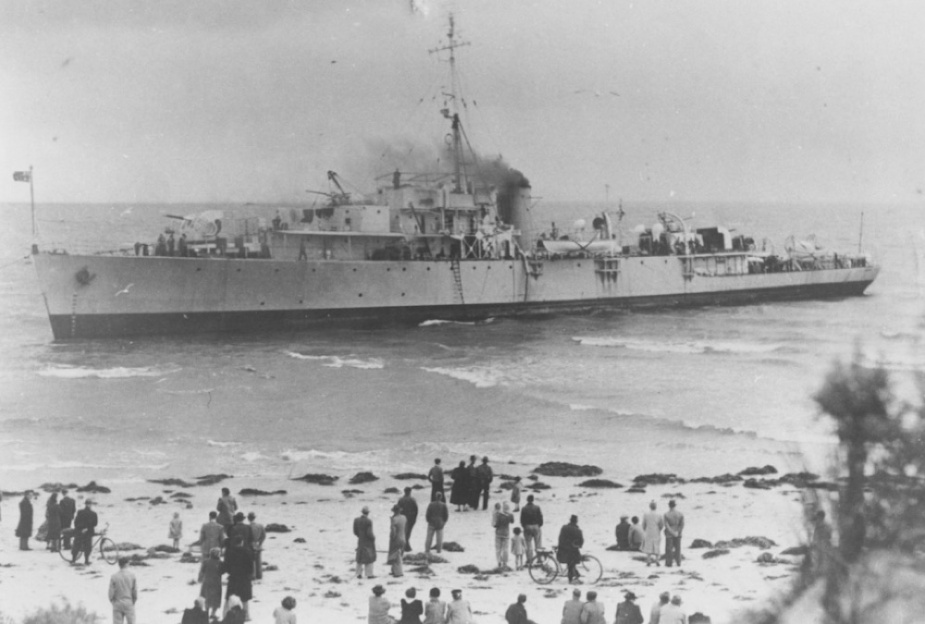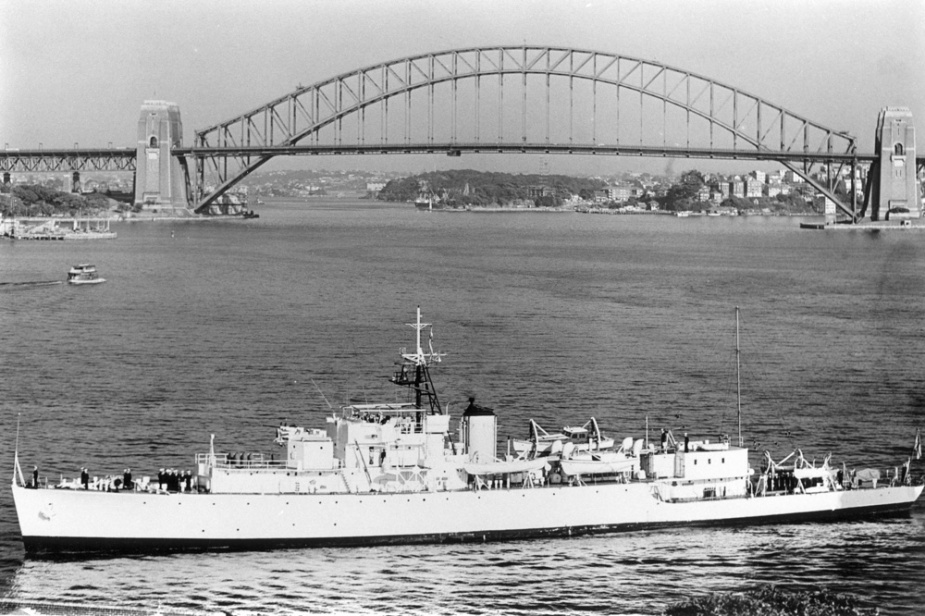
HMAS Barcoo was ordered as part of Australia’s shipbuilding program during the Second World War. Twelve of these Australian built frigates were to enter service with the Royal Australian Navy. A further ten were ordered but cancelled as the war drew to a close.
Eight, HMA Ships Barcoo, Barwon, Burdekin, Diamantina, Gascoyne (I), Hawkesbury (I), Lachlan and Macquarie, were built to the British River Class design and Australia likewise named its frigates after Australian rivers. A further four, HMA Ships Condamine, Culgoa, Murchison and Shoalhaven, were also named after Australian rivers but were built to the design of the Royal Navy’s Bay Class frigates. These latter ships were generally known as Modified River Class Frigates although they are sometimes referred to as Bay Class.
Barcoo commissioned at Sydney on 17 January 1944 under the command of Lieutenant Commander Alan J Travis RAN.
Following trials and a working up period, Barcoo proceeded to New Guinea waters in mid-March 1944 where she was for the first few weeks of active service engaged in convoy escort duties.
In early 1944, in company with HMAS Kapunda, she carried out bombardments of Japanese positions on Kar Kar Island and Banabun Harbour in east New Guinea. In June, July and August she was mainly engaged escorting convoys and transporting troops. On 28 August, en route to Langemak, she rescued two American Thunderbolt pilots from the sea.
In September 1944, after escorting the transport Katoomba to Darwin, Barcoo proceeded to Sydney for a short refit. She had then steamed some 30,000 miles on war service. She returned to New Guinea waters on 19 October 1944.
In November 1944, in company with HMA Ships Vendetta (I) and Swan (I), Barcoo operated in support of operations against Japanese forces in New Britain which included a series of bombardments in the Wide Bay area. Then followed more convoy escort and patrol duties in New Guinea waters, which ended in late January 1944 when she returned to Australia. Barcoo returned to New Guinea on 27 March 1945.
In April 1945 Barcoo proceeded to Morotai Island where she came under the operational control of Commander Task Force 78.1, Rear Admiral Royal USN, for the forthcoming operations against Japanese forces in Borneo. For the first Borneo landing at Tarakan on 1 May 1945, Barcoo operated as Senior Officer of the LCT Division of the invasion force. In June 1945 she took part in the Borneo operations at Brunei Bay, followed in July by escort duty to Morotai and general support to the Borneo campaign including bombardment of known and suspected Japanese positions on the east coast. The frigate fired her last hostile shots of the war when she bombarded Soengaipaten village in Borneo on 3 August 1945.
When hostilities ceased on 15 August 1945, Barcoo had steamed 72,000 miles. Until February 1946 she was engaged transporting troops and allied prisoners of war and on surveillance duties in the reoccupied areas north of Australia.
Following a refit and conversion at Williamstown Naval Dockyard in Melbourne, Barcoo commenced duty as a survey vessel in August 1946. For the next two years and eight months she was almost constantly engaged on survey duty in Australian and New Guinea waters. In this period she steamed some 54,000 miles. Survey duties are inherently hazardous and during a hurricane force storm on Sunday 11 April 1948 Barcoo was driven ashore off Glenelg, South Australia. The vessel was stuck fast for more than a week while efforts were made to refloat her. The ship was eventually refloated and towed into Port Adelaide.
In May 1949 Barcoo was placed in reserve at Sydney before recomissioning in March 1951 as a training ship mainly concerned with anti-submarine exercises.
In July 1952 Barcoo undertook extended survey duties around the Australian coastline until April 1956 when she returned to Sydney, paying off on 25 September, having steamed more than 100,000 miles since resuming seagoing service in March 1951.
Barcoo recommissioned for survey duties one last time on 7 December 1959 under the command of Lieutanant Commander Hugh WC Dillon, RAN and from then until 21 February 1964 she conducted hydrographic duties in the Lord Howe Island, Coffs Harbour, Portland, Port Lincoln, Montague Island, Granite Island and Western Australian coastal areas. During this period she steamed a further 103,778 miles bringing her seagoing total to 342,579 nautical miles since first commissioning. Following her final decomissioning she was placed in reserve and eventually sold for scrap on 15 February 1972 to NW Kennedy Ltd of Vancouver, Canada. During the following month the vessel left Sydney under tow for Hong Kong. It was intended that Barcoo would be broken up in Taiwan.
Further reading
- "HMAS Barcoo: The Story of a Ship & Her Ship"s Company" by Robert McAuslan. Published by IFIX PRINT Pty LTD, McMahons Point, NSW, 1995.
Specifications
 |
| Class |
River Class |
|---|---|
| Type |
Surface Combatant |
| Role |
|
| Pennant |
K375/F375/A245 |
| Motto |
We Clear the Way |
| Builder |
Cockatoo Docks and Engineering Co Ltd, Sydney |
| Laid Down |
21 October 1942 |
| Launched |
26 August 1943 |
| Launched by |
Mrs Keane, wife of the Minister for Trade and Customs |
| Commissioned |
17 January 1944 |
| Decommissioned |
21 February 1964 |
| Fate |
Sold for scrap on 15 February 1972 |
| Dimensions & Displacement | |
| Displacement |
|
| Length | 91.85 metres |
| Beam | 11.18 metres |
| Draught | 3.66 metres |
| Performance | |
| Speed | 20 knots |
| Range | 9593 kilometres at 12 knots |
| Complement | |
| Crew | 140 |
| Propulsion | |
| Machinery | 2 x Admiralty 3-drum boilers, 2 shafts, reciprocating vertical triple expansion, 5500 hp |
| Horsepower | 5500 |
| Armament | |
| Guns |
|
| Other Armament |
|
| Awards | |
| Battle Honours |
|



